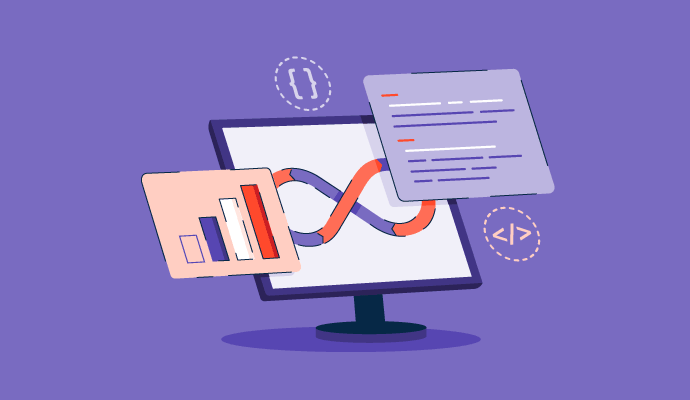Engineers develop software that makes our lives easier. A lot goes into their process because they have to focus on so many areas, like frontend and backend functionality and user experience (UX). The software development lifecycle governs this process, from user requirements to final deployment and maintenance.
As more businesses go digital, software development demand rises. Multiple new technologies, like no-code development platforms, help engineers to avoid hard coding applications and use drag-and-drop builders to create their vision.
All this has led to rapid innovation in the software development industry. Here are a few stats to help you keep up.
Software development trends and facts
Software development powers everything from smartphones to complex enterprise systems. The statistics below show the wealth of new opportunities in the sector.
- The number of software engineers worldwide is expected to reach $28.7 million by the end of 2024, an increase of 3.2 million in just 4 years.
- The United States has nearly 4.3 million software developers.
84.7%
of software development projects are driven by enterprises.
Source: TechReport
- By 2024, the IT sector is projected to surpass its pre-pandemic position, with an estimated compound annual growth rate (CAGR) of 5%.
- Experts expect the software development market to reach $1.3 million by 2027, with a CAGR of 22.54% from 2020 to 2027.
- India leads the world in IT outsourcing. It generated $585.57 billion in market revenue in 2023.
- About 85% of development teams use different programming languages for their projects.
- 90% of software development teams use functional testing as their primary testing technique.
- In 2021, the average annual base salary for software developers in the US was approximately $120,730. This ranks among the top 25 best-paying jobs. It’s the number one position in technology jobs.
- Over the last decade, the number of students taking software development courses worldwide has skyrocketed by 320%.
- Companies look for a few key things when hiring new software developers. 40.7% of them look for candidates with willingness to learn new things. 38.6% and 34.4% seek a good cultural fit and strong technical skills, respectively.
- Software companies will invest heavily in marketing in 2024. Software marketing is expected to receive 28% of all tech investment dollars.
- The shift to cloud services will be huge, reaching $55.9 trillion by 2030. This trend is already affecting the software industry, as the cloud services market grew by over $1.3 trillion in 2022.
- StackOverflow is the most popular online community for software developers. It generates over $50 million in revenue annually and is the most trusted online resource for developers, even with the rise of new tools like ChatGPT. The United States accounts for a major portion of StackOverflow's users; 20% of the website's traffic comes from there.
- 56% of developers prefer blockchain technology over any other methods.
Software development industry statistics
Software development is rising with new technologies like cloud computing and AI advancements. Below are some of the latest insights into the industry itself. Explore different opportunities in the sector.
- Cloud computing made up over 50% of global IT spending as of 2023.
- More than 85% of businesses use custom software solutions to improve operations.
- The developer community is made up of 91% male and almost 7% female developers.
- Software applications reduce operational costs by 47%.
- Software developers will increase by 25% every year from 2022 to 2032.
95%
of IT specialists feel open-source tools have become strategically important.
Source: BCG
- 75% of young people consider it crucial to understand software development.
- 60% of software developers are fully remote.
- Investments in software startups reached a record high of $120 billion in 2022.
- Over 40 million internet of things (IoT) devices will be present worldwide by 2025 and all of them will rely on intricate software for seamless functionality.
- Companies allocate 63% of their software development budgets to design and new development costs.
Software development methodology statistics
Businesses use agile, waterfall, scrum, and kanban methodologies in their development process. These methodologies guide processes, people, tools, and techniques involved in development projects. Let's take a look at how developers use these methodologies and what their preferences are.
- 68% of companies have adopted some form of agile methodology in their development processes.
- 22% of legacy systems primarily use the waterfall model despite having access to new tech.
- Agile gives a 64% success rate and waterfall methodology delivers at 49%.
- Java remains popular with 58% of large corporations that use it as a primary language.
- 63.6% of professional developers around the globe use Javascript.
- 72% of startups use Python for data science and web development applications.
- Users saw 34% of project failures due to incorrect programming language or toolset choice.
- 40% of companies have invested in specialized agile training programs for their teams. 50% of agile teams have implemented continuous delivery tools and practices into their workflows.
56%
of teams use scrum because it divides complex tasks into user stories and visually displays workflow.
Source: Adevait
- Scrum teams usually run two-week sprints. 87% of these teams successfully created a product increment after each sprint.
- 60% of banking institutions maintain legacy systems written in Common Business Oriented Language (COBOL).
- Adopting agile methodologies significantly improves project uncertainty management for 74% of developers.
- Projects using the waterfall methodology tend to take 20% longer than those using agile methods.
- 29% of teams blended practices from scrum and kanban methodologies to create a tailored approach.
- Smaller teams with six members or fewer show a 78% preference for agile methodologies. In comparison, larger teams of more than 20 people have a balanced distribution between agile and waterfall.
The importance of quality assurance and testing
Quality assurance (QA) and testing processes are crucial for software development. These statistics explore the industry's present state.
- 70% of organizations recognize the role of QA and testing as critical in handling business disruptions.
- 56% of defects during the software development lifecycle (SDLC) are from the design stage.
- 90% of software development teams use functional testing as the primary technique.
10%
of programmers did not measure application performance and had no plans to do so in 2022.
Source: Statista
- Automated testing adoption has risen by 85% over the past decade.
- 47% of businesses use open source tools for their testing processes.
- 30% of QA professionals use Selenium, the most popular testing tool.
- QA and testing typically make up 26% of software development budgets.
- Only 60% of projects adhere thoroughly to SDLC phases, which potentially leads to inefficiencies.
- 22% of software projects fail due to poorly defined requirements.
- The design phase usually takes up 30% of project time, while testing consumes 25%.
- 48% of software defects stem from errors in the requirement analysis phase.
- Inefficient coding practices identified in the implementation phase can slow down software performance by up to 70%.
- Regular feedback during the verification phase can decrease post-release defects by up to 45%.
- 82% of agile teams use continuous integration and continuous delivery (CI/CD) tools and pipelines to ensure consistency and quality.
Hone the right skills
Software development constantly adapts to new technologies and trend, making it one of the most in-demand and high-paying positions. On average, a software developer in the US earns around $129,200 in a year.
Whether it’s development, testing, or UX design, with the right skills, you’ll be able to make the most of opportunities. Get familiar with low-code and no-code platforms and gain capabilities so you can flourish in the software development space.
Want to explore more stats? Look at the present state of low-code development platforms.
 by Sagar Joshi / April 15, 2024
by Sagar Joshi / April 15, 2024
 by Sagar Joshi
by Sagar Joshi
 by Sagar Joshi
by Sagar Joshi
 by Sagar Joshi
by Sagar Joshi
 by Sagar Joshi
by Sagar Joshi
 by Sagar Joshi
by Sagar Joshi


